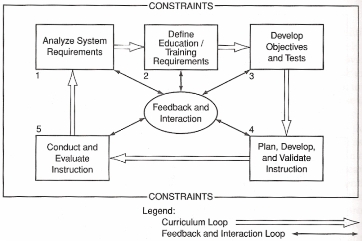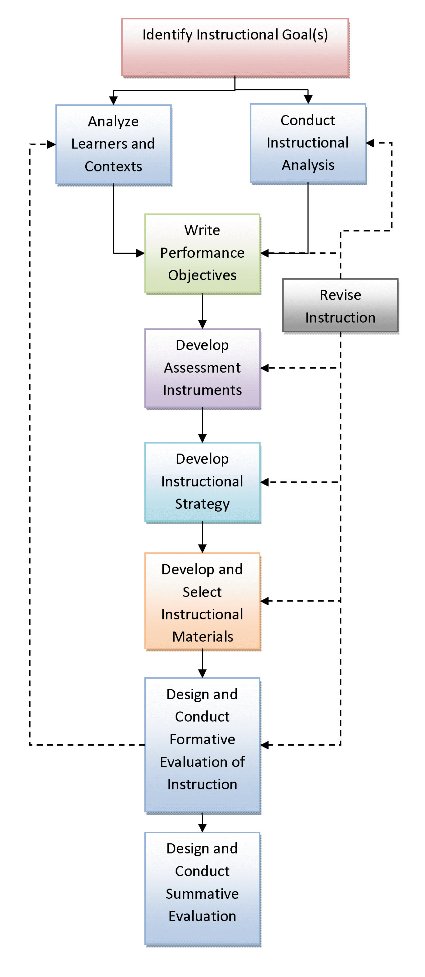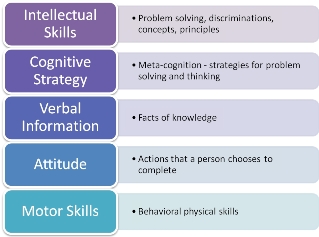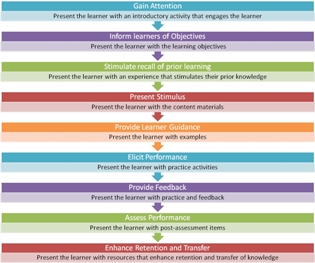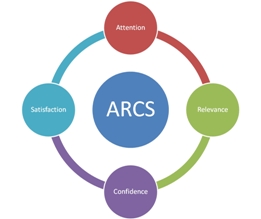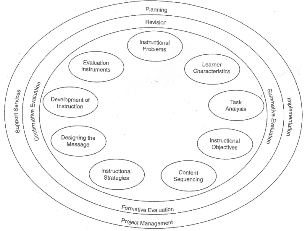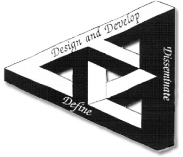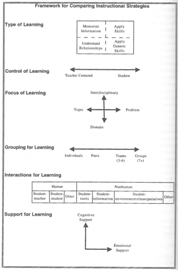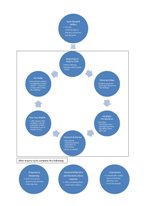Glossary
Air Force Model (1975) - The U.S. Air force model has five phases that are completed systematically but not necessarily linear. Although different phases of the model can be completed simultaneously, each step produces information that an instructional designer must use to accomplish later steps in the instructional systems design process (Seels & Glasgow, 1998). The Air Force Model also allows for feedback and interaction during each of its phases. This is to ensure that instructional designers reflect, communicate, and revise instructional materials to ensure that the instruction designed meets the needs of the clients. This model also emphasizes the management of both systems and instruction (Seels & Glasgow, 1998).
Air Force Model 1975 (adopted from Seels and Glasgow, 1998)
BACK TO TOP or BACK TO DOMAIN OF DESIGN
Dick and Carey Systems Approach Model (1996) - The Dick and Carey Systems Approach Model provides instructional designers with a more detailed approach than the ADDIE model. This model is a commonly utilized model that is comprised of interconnected boxes that drive the instructional design process. “The boxes represent sets of theories, procedures, and techniques employed by the instructional designer to design, develop, evaluate, and revise instruction” (Dick, Carey, & Carey, 2005). The Dick and Carey Model is presented to instructional designers in a linear format. At the same time, there is a major line that connects revision of instruction and feedback from the formative evaluation box back to the analysis portion of the model. This shows that even though the format is linear, instructional designers are constantly cycling through the process to make the revisions needed to ensure that the products satisfy the needs of both the learners and the clients.
Dick and Carey Systems Approach Model (adapted from Dick, Carey, & Carey, 2005).
BACK TO TOP or BACK TO DOMAIN OF DESIGN
Howard M. Gardner’s – Multiple Approaches to Understanding - Gardner’s goal is to present information to learners in a way that is tailored to the students’ multiple intelligences (Reigeluth, 1999).

Multiple Approaches to Understanding (adapted from H. M. Gardner, 1999)
BACK TO TOP or BACK TO DOMAIN OF DESIGN
Robert Gagne’s - Taxonomy of Learning (1985) - Robert Gagne’s Taxonomy of Learning categorizes learning into five major types of learning capabilities: intellectual skills, cognitive strategies, verbal information, attitude, and motor skills. Gagne’s taxonomy is utilized by instructional designers to identify prerequisite skills or knowledge that is necessary to learning. Also, Gagne’s Taxonomy of Learning (1985) can assist instructional designers through the process of sequencing instruction.
Gagne’s Taxonomy of Learning (adapted from R. M. Gagne, 1985)
BACK TO TOP or BACK TO DOMAIN OF DESIGN
Robert Gagne’s - Conditions of Learning Theory (1985) - Robert Gagne’s theory outlines a step-by-step process that involves nine steps that instructional designers must complete during the instructional design process. Gagne’s nine instructional events help instructional designers prescribe appropriate instructional strategies when designing and developing instructional materials. Each instructional event that Gagne lists requires instructional designers to think about the possible internal and external conditions that have an effect on the learning process (Gagne, 1985). Internal conditions are the already established learned capabilities of the learner or prior knowledge. External conditions deal with the presentation of stimuli to the learner (Gagne, 1985). The theory is based on information processing models that focus on the cognitive event that happen when learners are presented with a stimulus. Gagne’s theory is widely used in the instructional technology field because it can be adapted for all types of learning environments as well as all types of learning.
Gagne’s Conditions of Learning (adapted from R. M. Gagne, 1985)
BACK TO TOP or BACK TO DOMAIN OF DESIGN
Greer’s Instructional Development Project Management Model (1992) - Michael Greer’s project management model outlines the process of effectively managing an instructional development project. Greer’s model does not account for front-end analysis because Greer’s model assumes that a thorough front-end analysis has already been completed and training was deemed to be the most effective solution (Greer, 1992).
Instructional Development Project Management Model (adapted from M. Greer, 1992)
BACK TO TOP or BACK TO DOMAIN OF MANAGEMENT
John Keller’s - ARCS Model (1983) - John Keller’s ARCS model serves as a problem solving approach to designing motivational aspects to instruction. Keller’s model guides instructional designers through the process of designing and developing instructional materials that gain and keep the learner’s attention, make sure instruction is relevant to the learner, make sure learners are confident when completing the instructional objectives, and make sure learners are satisfied after instruction has happened (Keller, 1983).
Keller’s ARCS Model (adapted from J. M. Keller, 1983)
BACK TO TOP or BACK TO DOMAIN OF DESIGN
Kirkpatrick’s Four Levels of Evaluation Model (1998) - Kirkpatrick designed a model that was hierarchical and represented in a pyramidal shape. The are four different levels of Kirkpatick’s model that guide instructional designers through the process of gathering information then the designer builds on the information through the remaining levels.
- Reactions level - Determine how the learners felt about the training, the instructors, the environment, and assess learner attitudes towards the instruction.
- Learning level - Determine the amount of knowledge that the learners have retained from the training.
- Transfer level - Determine whether or not the training provided the learners with information that made it possible for applying the knowledge in real world situations
- Results level - Determine whether or not the training was effective by determining the return on investment for the instructional solution.
Kirkpatrick’s Four Levels of Evaluation Model (adapted from D. Kirkpatrick, 1998)
BACK TO TOP or BACK TO DOMAIN OF EVALUATION
Maslow’s Hierarchy of Needs (1943) - Abraham Maslow (1943) argued that “unique qualities of human behavior: love, self-esteem, belonging, self-expression, and creativity” facilitate the decision-making process that allows individuals to be responsible for their own destiny (Schwalbe, 2007). Maslow’s theory provides instructional designers with a hierarchical representation of needs that must be met for each individual on a project team. If individuals have all their basic needs met, then they can be motivated to take on work challenges that foster creativity (Maslow, 1943).

Hierarchy of Needs (adapted from A. Maslow, 1943)
BACK TO TOP or BACK TO DOMAIN OF MANAGEMENT
Richard Mayer’s - Cognitive Theory of Multimedia Learning (2001) - Focuses on three assumptions in regards to multimedia learning environments:
- People possess separate channels (visual and auditory) to process information.
- People have a limited capacity for how much information they can process at any given time.
- People participate in active processing of information by selecting relevant information, organizing information, and integrating knowledge acquired with representations of the information within their own minds. (p. 44).
Cognitive Theory of Multimedia Learning (adapted from R. E. Mayer, 2001)
BACK TO TOP or BACK TO DOMAIN OF DESIGN
Morrison, Ross, and Kemp Model (1994) - Morrison, Ross, and Kemp’s (MRK) model provides instructional designers with a cyclical model that does not present phases in the instructional systems design process in a linear manner. Instead, this model provides instructional designers with a model that can be used regardless of where an instructional designer starts within the process. The authors of this model believed that with each instructional design project, instructional designers should be able to choose the starting place and possibly change the order in which the steps of the process are completed. The MRK model provides instructional designers with a model that can be used when a client decides the specific instructional strategies, technologies, and/or delivery method that the instructional designer must utilize to complete a project.
Morrison, Ross, & Kemp Model (adopted from Morrison, Ross, & Kemp, 2007)
BACK TO TOP or BACK TO DOMAIN OF DESIGN
R2D2 Model (1995) - The R2D2 Model stands for recursive, reflective design and development (Willis, 1995). Recursive refers to the fact that decisions may be dealt with multiple times during the instructional systems design process because the R2D2 model does not require extensive analysis to be conducted (Seels & Glasgow, 1998). Reflective refers to how designers collaboratively provide feedback and reflection on the process to determine the best possible design and development of instructional materials (Seels & Glasgow, 1998). This model also focuses on design and development as a way of determining the learning objectives after focusing on creative solutions first. This is different from other ID models because the R2D2 model allows the instructional designer to collaborate and develop an instructional solution, while the objectives of the instruction become clearer as the project progresses. The define focus of the model deals with how instructional designers define the problem using the help of project team members and end-users as well. The disseminate focus of the model deals with diffusion and adoption rather than information gleaned from a summative evaluation.
R2D2 Model 1995 (adopted from Seels & Glasgow, 1998)
BACK TO TOP or BACK TO DOMAIN OF DESIGN
Reigeluth’s Description of Comparison Framework (1999) - Reigeluth provides instructional designers with a series of guiding questions that help to compare instructional design models to determine which model would be best based on the learning objectives, learner characteristics, and an environmental analysis. Using Reigeluth’s framework, designers compare models based on six points of comparison.
- Type of learning – Reigeluth provides four taxonomies that are distinct and interconnected simultaneously (1999). Depending on the type of learning that is going to occur during instruction, instructional designers can then look at ID models to determine which model addresses the same type of learning.
- Control of learning – The new paradigm of instructional theories shows that there is actually a continuum between the teacher centered approach and the learner centered approach. Depending on desired control of learning, instructional designers can compare ID models to find a model that matches with the desired control of learning.
- Focus of learning – Reigeluth’s framework compares both content and the learning activity that is taking place during instruction (1999). The focus of learning can be topic or problem oriented, as well as, interdisciplinary or domain specific. Reigeluth’s comparison framework guides the instructional designer in determining which ID model will provide the type of learner activities that fit the instructional content.
- Grouping for learning – Reigeluth’s framework simply helps instructional designers think about how the learners will be learning (1999). Are the learners going to work together as a big group or a small group? Are the learners going to work individually and then come together to collaborate and share ideas? Instructional designers answer these questions and then use the answers to determine which ID model utilizes the same grouping.
- Interactions of learning – Reigeluth divides interactions into two categories: human and non-human (1999). Interactions can occur between teacher and student, student and tools, student and student, etc. Reigeluth’s framework helps to determine which type of interactions are going to occur during instruction. Once that has been identified by the instructional design, then an ID model can be chosen.
- Support for learning – Reigeluth compares ID models based on the level of cognitive and emotional support given to learners. Cognitive support deals with the way in which the instruction will support learners through the process of building an understanding of the content (Reigeluth, 1999). Emotional support deals with the learner’s feelings and how to provide the needed elements of support to ensure learners are motivated and confident (Reigeluth, 1999). Depending on the strategies outlined in the ID models, instructional designers can compare and determine the best model to utilize to support the learners.
Framework for comparing instructional strategies(adopted from Reigeluth, 1999)
BACK TO TOP or BACK TO DOMAIN OF DESIGN
Rogers’ Diffusion of Innovation Model (1995) - Rogers’ model consists of five stages that occur during the innovation-decision process: knowledge, persuasion, decision, implementation, and confirmation (1995).
- Knowledge - Potential adopters are taught about the different functions of the innovation.
- Persuasion - After potential adopters are knowledgeable of the innovation, the adopters form opinions about the innovation and persuade others.
- Decision - Adopters complete activities to determine whether reject or accept the innovation.
- Implementation – The innovation is installed within the organization.
- Confirmation – Decision to accept or reject the innovation if finalized and institutionalization occurs if the innovation is accepted. (Rogers, 1995).
Roger’s Diffusion of Innovation Model (adopted from E. M. Rogers, 1995)
BACK TO TOP or BACK TO DOMAIN OF UTILIZATION
Schwartz, Lin, Brophy, and Bransford’s - Flexibly Adaptive Instructional Design - Schwartz et al. developed a framework that supports flexibly adaptive design that outlines ten steps to effectively design instruction. The goal of this model is to provide instruction that requires problem solving, collaboration, and communication within a problem-based learning environment (Reigeluth, 1999).
Representation of Flexibly Adaptive Instructional Design (adapted from Schwartz et al., 1999)
BACK TO TOP or BACK TO DOMAIN OF DESIGN
Seels and Glasgow’s ISD Model II: For Practitioners (1997) - Seels and Glasgow’s instructional design model assumes that project management is the context within which design occurs. Seels and Glasgow’s model (1997) calls for the formulation of a project management plan. The model breaks the instructional design process into three phases:
- “needs analysis management;
- instructional design management; and
- implementation and evaluation management” (Seels and Glasgow, 1997, p. 177).
At the same time, instructional designers utilize diffusion of innovation strategies during each phase to ensure that successful implementation and institutionalization occurs.
ISD Model II: For Practitioners (adopted from Seels & Glasgow, 1998)
BACK TO TOP or BACK TO DOMAIN OF MANAGEMENT
John Sweller’s - Cognitive Load Theory (1988) - John Sweller builds a theory based on George Miller’s research on short term memory. Sweller theorizes that the chunking or combination of elements that an individual learns during the learning process makes up that individual’s knowledge base (Sweller, 1988). Sweller further explains that working (short-term) memory has a limit. When there is an overstimulation of the working memory then it is hard for learners to retain the new information and convert it to long-term memory. By chunking information into manageable parts, learners can convert information from short-term to long-term memory. Once the learner has committed the information to long-term memory, the learner can then recall the information to working memory when needed.
BACK TO TOP or BACK TO DOMAIN OF DESIGN
Thamhain and Wilemon’s Influence and Power (1977) - Thamhain and Wilemon’s theory is utilized by instructional designers to determine what type of power and influence is necessary to motivate project team members. Power is considered to be more significant than influence (Schwalbe, 2007). The following graphic represents the balance between the different types of power and the different ways to influence people. As project managers, instructional designers must strike a balance to ensure the success of a project.
Thamhain and Wilemon’s Influence and Power (adapted from Thamhain and Wilemon, 1997)
